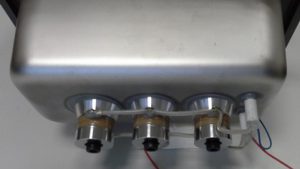Aktive Arc Ultrasonics provides high power ultrasonic systems to a wide range of industrial and research clients. We specialize in adapting power ultrasonics to most any process and application. We specialize in design of custom ultrasonic elements and process integration.
Choosing a “High Power” Ultrasonic System
There are many types of ultrasonic systems available off-the-shelf and a number of ways to customize conventional systems to meet your requirements. So what type of ultrasonic system is best for your application or research project?
Pease contact us and we will be happy to assist you in your decision.
Do you need an Ultrasonic Processor or an Ultrasonic Bath?
(This video is Part 1 of Tip #1, a basic tutorial on ultrasonic processors)
In general terms if you want focused energy such as many tens, hundreds, or thousands of watts in a small volume choose an ultrasonic processor with an appropriate sonotrode. These devices can produce dense cavitation with strong acoustic streaming that will provide excellent shear and mechanical mixing for dispersion and emulsions, diffusion, and can make rapid chemical reactions. If you want moderate energy dispersed over a wider area choose an ultrasonic bath. Here are some details about how these systems are constructed and what they can offer.
Ultrasonic Processors with a Sonotrode (a.k.a. Probe or Horn) are typically characterized as systems with a single transducer capable of relatively high power and generating higher amplitude (sonotrode tip displacement).
The Transducer can be complemented with wide ranging combinations of Booster elements  and Sonotrode types.
and Sonotrode types.
The Booster elements are not required however they often offer a convenient method of mounting the acoustic assembly. They are a very effective means of increasing or decreasing the amplitude and resulting power delivered to the material or liquid being processed. Typical Booster amplitude ratios are 1:0.6 (amplitude reduction), 1:1 (no gain), 1:1.5 (50% amplitude gain), 1:2 (2 times amplitude gain), 1:2.5 (2.5 times amplitude gain).
The Sonotrode (a.k.a probe or horn), the active working end of the acoustic stack, comes in contact with the materials under treatment. These can take a wide variety of shapes from cylindrical to rectangular. Like the boosters they can be shaped to increase or decrease the amplitude. The shape will also determine whether the energy is focused on the end tip, in select nodal points, or over the entire length.
These systems can deliver sonotrode tip face Power Intensity in the range of 10 to 400 W/cm2. In a one liter container the liquid volume Power Density could be for example from 10 to 600 watts per liter. Understanding and monitoring these power conditions in your research and development phase will be very valuable in the scale up of your process.
- The output energy may be focused on the Sonotrode end tip for extremely high focused energy, e.g. hundreds of watts from a small surface area. Go to Video Page to see example 19 mm diameter Sonotrode in water.
- The energy may be dispersed over select nodal areas along the length and tip of the sonotrode. The larger sections at the middle and end in this example.
 These focused areas can produce many tens or hundreds of watts per square centimeter.
These focused areas can produce many tens or hundreds of watts per square centimeter.
- The energy may be dispersed over the entire length of the sonotrode. This last method produces surface power per square centimeter that can be similar to an ultrasonic bath. Depending on the length of the sonotrode and applied power the range could for example be from a 0.5 to 10 watts per square centimeter. Go to Video Page to see example 38 mm diameter Sonotrode in water.
Ultrasonic Bath
(Video Part 2 of Tip #1, a basic tutorial about ultrasonic bath)
These systems normally vibrate a metal plate with one or many low amplitude transducers.

(Ultrasonic Bath – Bottom Transducers)
This active plate is often part of the bath surface, typically the bottom surface, but may also be part of an immersible box assembly.
The bath liquid must be capable of propagating the acoustic energy from the vibrating plate. Ultrasonic bath systems normally produce low amplitude and power ranging from a few watts to thousands of watts. Here are some equipment selection considerations.
- The output energy is dispersed over the total volume of liquid in the bath. Therefore understanding the bath volume Power Density, watts per liter or W/cm3, will be helpful in evaluating relative power between various size baths and their ultrasonic power output capabilities. For example a 10 liter bath capable of producing 500 watts of energy will have volume power density of 50 watts per liter.
- The type of transducers and the number used on a given plate surface area will significantly change the vibrating plate surface Power Intensity (W/cm2) and the resulting volume power density. Normally the surface power intensity is <1 watt to a few W/cm2 .
As you can see there are significant differences between an ultrasonic processor with a focused high energy sonotrode and an ultrasonic bath with uniform energy over a large surface.
There are many more considerations that will very much depend on the type of material you are treating. Are they solids, slurries, or liquids and what is the viscosity? How far will acoustic energy penetrate these materials and how can you overcome system limitations are important considerations that we can help you understand. Please feel free to contact us for more advice.
Copyright © 2023 by Aktive Arc Sarl. All rights reserved. Reproduction Prohibited.
